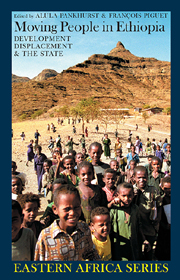Book contents
- Frontmatter
- Contents
- Acknowledgements
- Acronyms
- Glossary
- Notes on Contributors
- Preface: An Original Contribution to Country-wide Displacement Analysis
- Foreword by Alula Pankhurst & François Piguet
- Map
- Part I INTRODUCTION
- Part II THEORETICAL & INTERNATIONAL PERSPECTIVES
- Part III DEVELOPMENT-INDUCED DISPLACEMENT
- Part IV THE EXPERIENCE OF STATE-ORGANIZED RESETTLEMENT
- Part V THE DILEMMAS OF REFUGEES, RETURNEES & DISPLACED GROUPS
- 12 In the Mouth of the Lion
- 13 Returnees' Experiences of Resettlement in Humera
- 14 War, Displacement & Coping
- 15 From Young Soldiers to Adult Civilians
- Part VI CONCLUSION
- Bibliography
- Index
- EASTERN AFRICAN STUDIES
14 - War, Displacement & Coping
from Part V - THE DILEMMAS OF REFUGEES, RETURNEES & DISPLACED GROUPS
Published online by Cambridge University Press: 05 April 2013
- Frontmatter
- Contents
- Acknowledgements
- Acronyms
- Glossary
- Notes on Contributors
- Preface: An Original Contribution to Country-wide Displacement Analysis
- Foreword by Alula Pankhurst & François Piguet
- Map
- Part I INTRODUCTION
- Part II THEORETICAL & INTERNATIONAL PERSPECTIVES
- Part III DEVELOPMENT-INDUCED DISPLACEMENT
- Part IV THE EXPERIENCE OF STATE-ORGANIZED RESETTLEMENT
- Part V THE DILEMMAS OF REFUGEES, RETURNEES & DISPLACED GROUPS
- 12 In the Mouth of the Lion
- 13 Returnees' Experiences of Resettlement in Humera
- 14 War, Displacement & Coping
- 15 From Young Soldiers to Adult Civilians
- Part VI CONCLUSION
- Bibliography
- Index
- EASTERN AFRICAN STUDIES
Summary
This chapter covers war stories from villages and describes cases of families affected by the 1998–2000 Ethio-Eritrean conflict, divided into three parts relating to the situations before, during and after the war. Differences between a town and two rural villages are discussed. The chapter concludes with a discussion of the impact of war on border villages in relation to identity.
Before the war: competition for economic and political dominance
Zalanbesa, a small border town, was an economically fast-growing centre in North-Eastern Tigray. Statistics put the population at 6,059, of whom 2,756 were males and 3,303 females (CSA 1995b). Zalanbesa benefited from being situated on the main road between Adigrat and Asmara. Commercial activity in the area gained momentum, after Zalanbesa became a border town following the independence of Eritrea. Food items and livestock were smuggled across the border to Eritrea while goods such as textiles and beer were brought to the Ethiopian market. Many of the town's residents benefited directly or indirectly from these activities.
Zalanbesa reflects in microcosm the difficult relationship between the two countries following Eritrea's independence. Only an estimated one-fifth of the population was Eritrean, but they were dominant among the well-off and trading classes. As a border town, Zalanbesa also represented the continuities and mixtures of identities. The socio-cultural homogeneity of villages and the cross-border bonds of kinship made the relationship more complex.
- Type
- Chapter
- Information
- Moving People in EthiopiaDevelopment, Displacement and the State, pp. 210 - 233Publisher: Boydell & BrewerPrint publication year: 2009



